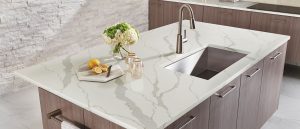Introduction
Quartz with veining is a popular choice for countertops and other surfaces due to its natural appearance and durability. In this article, we will delve into the manufacturing process of quartz with veining, detailing each step involved.
Raw Material Selection
To begin the manufacturing process, high-quality quartz aggregates are carefully selected. These aggregates serve as the base material for the quartz slabs. The selection process ensures uniformity in color and texture, which is essential for achieving the desired veining effect.
Mixing and Coloring
The selected quartz aggregates are then mixed with resin binders and pigments in precise proportions. The pigments are added to mimic the natural veining found in materials such as marble or granite. Advanced mixing techniques ensure thorough dispersion of pigments throughout the mixture, resulting in consistent coloration and veining patterns.
Molding and Pressing
Once the mixture is ready, it is poured into molds of predetermined sizes and shapes. Hydraulic presses apply immense pressure, typically ranging from 100 to 200 bars, to compact the mixture and remove air pockets. This compression process enhances the strength and density of the quartz slabs, making them suitable for various applications.
Curing
After molding and pressing, the quartz slabs undergo a curing process to strengthen the bond between the quartz aggregates and resin binders. Curing typically takes place in specialized ovens at controlled temperatures ranging from 90 to 100 degrees Celsius. The duration of curing varies depending on the thickness of the slabs but typically lasts between 30 to 45 minutes.
Calibration and Polishing
Once cured, the quartz slabs are calibrated to ensure uniform thickness and flatness. Precision machinery equipped with diamond-tipped blades carefully trims the edges of the slabs to achieve desired dimensions. Subsequently, the slabs undergo a series of polishing steps using abrasive pads of varying grit sizes. This process results in a smooth, glossy surface that accentuates the veining patterns.

Quality Control
Throughout the manufacturing process, rigorous quality control measures are implemented to uphold the highest standards. Random samples are regularly tested for dimensions, color consistency, and veining pattern accuracy. Any deviations from specifications are promptly identified and addressed to maintain product integrity.
Conclusion
In conclusion, the manufacturing of quartz with veining involves a meticulous process that combines advanced technology with craftsmanship. From raw material selection to final quality control, each step is crucial in achieving the desired aesthetic and performance characteristics. The resulting quartz slabs offer the beauty of natural stone with the added benefits of durability and versatility.
